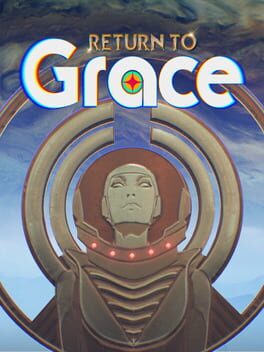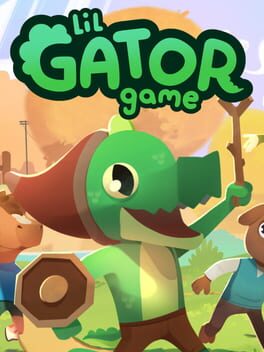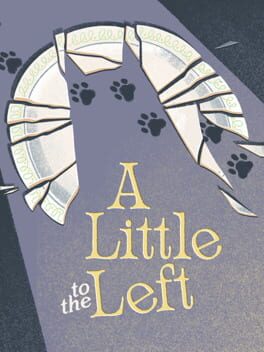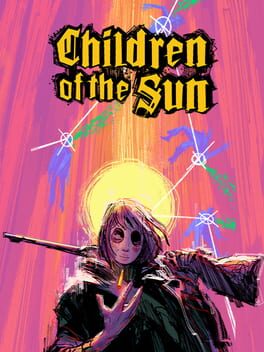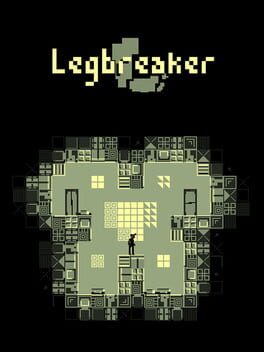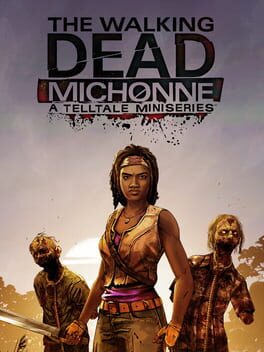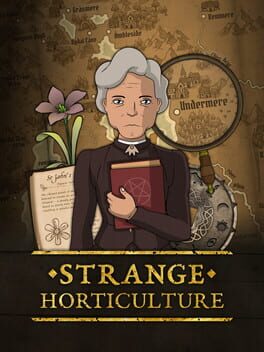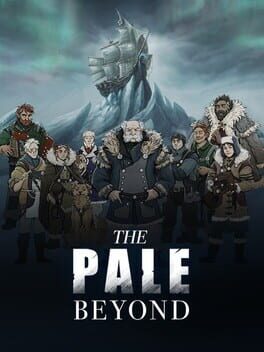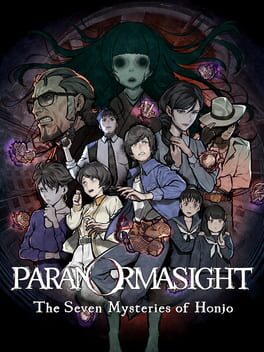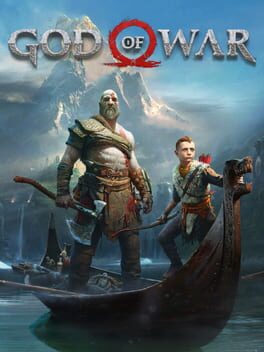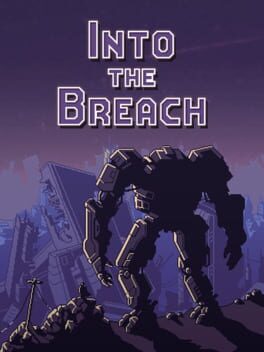Angry_Kurt
145 reviews liked by Angry_Kurt
I really wanted to love this game. It had an interesting premise, beautiful visuals, and some really enjoyable platforming sections that reminded me of the latest Prince of Persia game. Unfortunately, the combat arenas become tedious; it's very easy to get soft locked into an unavoidable series of attacks until you die over and over again. Along with the frustrating combat, there were far too many instant kill environmental hazards with terribly vague hit boxes and a reliance on lengthy autoscrolling sections around the boss battles that just became a chore. I felt I had to see it through to the end to see how the story concluded, which – despite having some touching moments throughout – led to quite a weak conclusion.
Return to Grace
2023
I will start by saying Return to Grace isn’t great, but it is good. It’s a walking simulator that I know isn’t a genre that appeals to everyone, but it’s short and sweet with enough little bits of interactivity to keep the pace steady and not monotonous.
You take control of a future space archaeologist, Adie Ito, who’s ended up on Ganymede (one of Jupiter’s moons) at the resting place of Grace: an AI seemingly worshipped as a god.
Here there is no life left but you quickly discover a piece of Grace.
The first of which represents her logic processing and is quickly dubbed Logic as expected.
Throughout searching this retro-future facility you have different aspects of Grace come into existence all with distinct personality traits.
These characters (I guess technically character singular) are excellently presented, with a great variety of voice acting and all give different and interesting perspectives on what may have happened to Grace, her purpose and views on Adie herself.
Presentation isn’t just from great voice acting, Adie has a little computer mounted on her left wrist which is used for some puzzles but mostly shows simply differently expressive and coloured faces to represent each of these personalities you interact with.
Other interactions involve climbing, pulling levers, small button puzzles and a couple more interesting things that I don’t want to spoil from this game’s extremely short run-time.
Graphically the game is neat, smooth and shiny. Quality lighting and the aesthetic is somewhat 60’s sci-fi but with a good variety of interesting locals to keep you engaged.
If you enjoy walking simulators and especially if you have access to Game Pass this is worth a pick up.
It took me a little over two hours to get through and I did reload some saves to check out alternate choices which can end up with a couple of different endings.
Strangely Return to Grace is more full than you’d expect a two hour story to be in terms of little touches, variation of locations and characters but also feels fairly basic too.
It isn’t doing anything new or particularly innovative and the story is good but it’s a little predictable.
Return to Grace doesn’t feel like the clearly talented staff stretch out further than what they know they can do but while it means it doesn’t necessarily excite it does do everything to a level of quality that’ll not have you upset if you spent a couple of hours with it.
You take control of a future space archaeologist, Adie Ito, who’s ended up on Ganymede (one of Jupiter’s moons) at the resting place of Grace: an AI seemingly worshipped as a god.
Here there is no life left but you quickly discover a piece of Grace.
The first of which represents her logic processing and is quickly dubbed Logic as expected.
Throughout searching this retro-future facility you have different aspects of Grace come into existence all with distinct personality traits.
These characters (I guess technically character singular) are excellently presented, with a great variety of voice acting and all give different and interesting perspectives on what may have happened to Grace, her purpose and views on Adie herself.
Presentation isn’t just from great voice acting, Adie has a little computer mounted on her left wrist which is used for some puzzles but mostly shows simply differently expressive and coloured faces to represent each of these personalities you interact with.
Other interactions involve climbing, pulling levers, small button puzzles and a couple more interesting things that I don’t want to spoil from this game’s extremely short run-time.
Graphically the game is neat, smooth and shiny. Quality lighting and the aesthetic is somewhat 60’s sci-fi but with a good variety of interesting locals to keep you engaged.
If you enjoy walking simulators and especially if you have access to Game Pass this is worth a pick up.
It took me a little over two hours to get through and I did reload some saves to check out alternate choices which can end up with a couple of different endings.
Strangely Return to Grace is more full than you’d expect a two hour story to be in terms of little touches, variation of locations and characters but also feels fairly basic too.
It isn’t doing anything new or particularly innovative and the story is good but it’s a little predictable.
Return to Grace doesn’t feel like the clearly talented staff stretch out further than what they know they can do but while it means it doesn’t necessarily excite it does do everything to a level of quality that’ll not have you upset if you spent a couple of hours with it.
Lil Gator Game
2022
It may be a lil game, but it has a lot of heart. Maybe best described as “My First Open World” or "Breath of the Wild Jr" and this is not as much of an insult as it may sound.
Two points I know I like to know when hearing about a game I can tick off almost instantly in this review are the questions “is it any good?” and “how long is it?” by simply telling you that I finished the game in one sitting that took around three hours and the only thing that stopped me immediately cleaning up everything the game had to offer was it was time to feed the dog.
Once that had been done and I ate dinner myself I spent around another hour doing the rest.
So yes it’s good, and roughly 3-4 hours in length to do everything.
This may not be enough information to satisfy your interest so I will elaborate.
Lil Gator Game is a small open-world game mostly based on movement, some simple platforming, swimming, climbing, floating about and more thanks to a range of interesting items your hero picks up along the way.
Structure wise you are free to roam in whatever direction you like once you’ve completed the quests on the small, BOTW-like, tutorial island, in which you pick up the key three ingredients a hero needs - a sword, a shield and a hat.
About the island are many NPCs that you are aiming to befriend to create a town hub for everyone and impress your Big Sis, but more on that later.
Each of these would-be friends will have small quests for you, some range from clearing out nearby enemies, to classics such as fetch-quests or multi-part adventures where you’re needing to help separate folk to get the attention of one specific pal.
There are weapons, your sword of many varieties and later some ranged tools but the enemies… well they are cardboard cutouts so they don’t put up much (any) resistance.
“Combat” is really just a way of collecting things in the vein of coins, rings, rupees or whatever.
As mentioned earlier Lil Gator Game is more about movement. You can climb anything and, again like BOTW, have a stamina gauge that can be upgraded. Your shield has no need for defense as you can’t be attacked so instead you can use it like a sled, but as the first example of many, just sliding, is not all that the shield does movement wise and this shows the surprising depth Lil Gator Game has with its mechanics.
Different shields can slide in different ways, on top of this jumping while on the shield at the right point can bounce you further and this even includes some quite satisfying skimming along water.
None of these techniques are essential, you’re under no stress, you don’t need to go anywhere in a particular order or under a time-limit but the freedom of fun and discovery is there.
As you collect more items these movement abilities you have expand in the ways you would you expect, like better climbing, gliding and more, but also expand in a couple of fun ways you may not expect such as, minor spoiler, collecting a ninja headband that makes you Naruto run - which is faster.
Lil Gator Game doesn’t have every element or the sheer scale of a Breath of the Wild but it condenses a lot of what the joy of that game is into a tight package which has a cute, child-like aesthetic.
The aesthetic of big blocky colours, speech bubbles, googly eyes and cardboard cut-outs really work as a pleasant vibe that reflects its narrative.
You Big Sis as mentioned earlier, is back on a break from college and you want her attention. You see, as the game reveals from the start, you and her used to play and she was great at making rules for fun games and you were both heavily inspired by (for legal reasons not)The Legend of Zelda.
Sadly for our protagonist, time has passed, you’ve both aged and your Big Sis is busy with assignments and doesn’t seem to have time to play.
Your quest, to get her to remember the fun you had and grab her attention.
Lil Gator Game does a magically wonderful job of capturing a lot of what being a child feels like, and does a good job of giving you a view of this world through a child’s eyes.
The dialogue is fun, it isn’t minimised to monosyllabic words or baby sounding pronunciations though, if anything I wonder if a failing Lil Gator Game might have is that it presents itself for kids but is more for adults with nostalgia when considering how much dialogue there is throughout.
The ending especially, I will not describe the feeling as to not spoil, but it did make me a little glassy-eyed, an effect I don’t imagine it would have on a child but perhaps their parents.
Lil Gator Game is exactly as described in my opening sentence and it does it very well but this does leave stages feeling a little too simple and potentially repetitive.
I will take a moment to applaud the post-game as “cleaning up” in open-world games is a task for the sick honestly, but “gamer brain” does mean that an 87% for example, must become 100% or I can’t sleep and this title makes it as easy as possible.
It isn’t quite doing it all for you but it gives as much a helping hand that if anymore would mean you could just put the pad down and line, they manage to hit perfectly and give you a small reward for your time which feels as sweet as the rest of the experience.
For all of its child-like fun and wonder in design and aesthetic, Lil Gator Game is maturely put together, well-crafted and feels truly sincere. If you need a short game for a palette cleanser, but you still want a sense of play and not just story - you can’t go too wrong with grabbing this title or playing it for “free” via GamePass.
Two points I know I like to know when hearing about a game I can tick off almost instantly in this review are the questions “is it any good?” and “how long is it?” by simply telling you that I finished the game in one sitting that took around three hours and the only thing that stopped me immediately cleaning up everything the game had to offer was it was time to feed the dog.
Once that had been done and I ate dinner myself I spent around another hour doing the rest.
So yes it’s good, and roughly 3-4 hours in length to do everything.
This may not be enough information to satisfy your interest so I will elaborate.
Lil Gator Game is a small open-world game mostly based on movement, some simple platforming, swimming, climbing, floating about and more thanks to a range of interesting items your hero picks up along the way.
Structure wise you are free to roam in whatever direction you like once you’ve completed the quests on the small, BOTW-like, tutorial island, in which you pick up the key three ingredients a hero needs - a sword, a shield and a hat.
About the island are many NPCs that you are aiming to befriend to create a town hub for everyone and impress your Big Sis, but more on that later.
Each of these would-be friends will have small quests for you, some range from clearing out nearby enemies, to classics such as fetch-quests or multi-part adventures where you’re needing to help separate folk to get the attention of one specific pal.
There are weapons, your sword of many varieties and later some ranged tools but the enemies… well they are cardboard cutouts so they don’t put up much (any) resistance.
“Combat” is really just a way of collecting things in the vein of coins, rings, rupees or whatever.
As mentioned earlier Lil Gator Game is more about movement. You can climb anything and, again like BOTW, have a stamina gauge that can be upgraded. Your shield has no need for defense as you can’t be attacked so instead you can use it like a sled, but as the first example of many, just sliding, is not all that the shield does movement wise and this shows the surprising depth Lil Gator Game has with its mechanics.
Different shields can slide in different ways, on top of this jumping while on the shield at the right point can bounce you further and this even includes some quite satisfying skimming along water.
None of these techniques are essential, you’re under no stress, you don’t need to go anywhere in a particular order or under a time-limit but the freedom of fun and discovery is there.
As you collect more items these movement abilities you have expand in the ways you would you expect, like better climbing, gliding and more, but also expand in a couple of fun ways you may not expect such as, minor spoiler, collecting a ninja headband that makes you Naruto run - which is faster.
Lil Gator Game doesn’t have every element or the sheer scale of a Breath of the Wild but it condenses a lot of what the joy of that game is into a tight package which has a cute, child-like aesthetic.
The aesthetic of big blocky colours, speech bubbles, googly eyes and cardboard cut-outs really work as a pleasant vibe that reflects its narrative.
You Big Sis as mentioned earlier, is back on a break from college and you want her attention. You see, as the game reveals from the start, you and her used to play and she was great at making rules for fun games and you were both heavily inspired by (for legal reasons not)The Legend of Zelda.
Sadly for our protagonist, time has passed, you’ve both aged and your Big Sis is busy with assignments and doesn’t seem to have time to play.
Your quest, to get her to remember the fun you had and grab her attention.
Lil Gator Game does a magically wonderful job of capturing a lot of what being a child feels like, and does a good job of giving you a view of this world through a child’s eyes.
The dialogue is fun, it isn’t minimised to monosyllabic words or baby sounding pronunciations though, if anything I wonder if a failing Lil Gator Game might have is that it presents itself for kids but is more for adults with nostalgia when considering how much dialogue there is throughout.
The ending especially, I will not describe the feeling as to not spoil, but it did make me a little glassy-eyed, an effect I don’t imagine it would have on a child but perhaps their parents.
Lil Gator Game is exactly as described in my opening sentence and it does it very well but this does leave stages feeling a little too simple and potentially repetitive.
I will take a moment to applaud the post-game as “cleaning up” in open-world games is a task for the sick honestly, but “gamer brain” does mean that an 87% for example, must become 100% or I can’t sleep and this title makes it as easy as possible.
It isn’t quite doing it all for you but it gives as much a helping hand that if anymore would mean you could just put the pad down and line, they manage to hit perfectly and give you a small reward for your time which feels as sweet as the rest of the experience.
For all of its child-like fun and wonder in design and aesthetic, Lil Gator Game is maturely put together, well-crafted and feels truly sincere. If you need a short game for a palette cleanser, but you still want a sense of play and not just story - you can’t go too wrong with grabbing this title or playing it for “free” via GamePass.
A Little to the Left
2022
Cosy, wholesome, zen. I don’t outright hate these terms when discussing video games but as discussed on The Computer Game Show trying to use those terms as a genre title feels, incorrect, possibly disingenuous.
Horror is a genre, not “scary”, the decision of what something feels like is up to its audience.
It may sound redundant but acting as if cosy is a genre is the equivalent to filing a game under “fun”.
I have definitely used these words to describe games in the past. I am a fan of having games that I can relax with, zone out a little and not feel pressured or even stressed.
A Little to the Left aims for a feeling of being cosy, simple and just nice. Organising varying objects into a tidy manner as a simple puzzle, while along the way introducing a long-haired white cat to add to the everyday wholesome feeling the game is aiming for, using this cat as a game mechanic to either mess with your tidying or as a theme to the puzzles.
I love cats, but I feel that, let’s just call them “cat people”, end up elevating a lot of things that include cats to a pedestal they do not deserve.
This again just added to a feeling which may make me sound miserable, of being told I should like something which had me push back against it.
I will decide whether the game is wholesome, not the game itself.
As far as the organising and puzzles, A Little to the Left fails to do either in a way that really landed with me.
In terms of organising, the feeling is enjoyable for a moment and quickly repetitive. These items other than feeling quite “everyday” don’t really do anything else but act as icons, there is no story within them unlike Unpacking - the game I would say really pushed this subgenre.
The puzzles again are repetitive, organise by size, organise in a colour gradient, make something symmetrical, there is really not much else to them other than this.
Once you understand the game’s language, what it decides is organised, you can solve each puzzle within seconds, maybe replaying for different solutions but quickly moving on.
Another issue with the puzzles themselves is the interactions of simply picking up and putting stuff down never feels precise enough and also doesn’t feel marked out enough to do quickly.
Many times I would have items in the right order but the game had me fiddle with the items until lined up perfectly and that in my eyes, doesn’t feel relaxed or cosy, it feels annoying and like busy work. I will also add here that one puzzle the game would not allow me to solve even though I had everything correct (I ended up using the hint and then guides to check) but because it wouldn’t progress I spent minutes fiddling for no gain.
Sadly repetition is the biggest flaw of A Little to the Left and the finale really ramps this to a stage where I found myself saying “I don’t care about this cat”.
Perhaps there is an argument that I should have played this game in shorter bursts and to a degree I agree with that assessment. However, this further enforces the final point I’d like to make about this game. It’s in the wrong format.
This title is on PC and all the modern consoles, and outside of the Switch and maybe the Steam Deck I don’t think this fits. It has “mobile game” written all over it and whilst I don’t intend that to be an insult it does make it feel wrong playing on a bigger screen.
Multiple stages with tiny puzzles and little in the way of connective thread throughout them just reminds me of the classic games on iOS such as Angry Birds, Cut the Rope or even Monument Valley although that feels more narratively driven.
A Little to the Left is a Little Disappointing.
Horror is a genre, not “scary”, the decision of what something feels like is up to its audience.
It may sound redundant but acting as if cosy is a genre is the equivalent to filing a game under “fun”.
I have definitely used these words to describe games in the past. I am a fan of having games that I can relax with, zone out a little and not feel pressured or even stressed.
A Little to the Left aims for a feeling of being cosy, simple and just nice. Organising varying objects into a tidy manner as a simple puzzle, while along the way introducing a long-haired white cat to add to the everyday wholesome feeling the game is aiming for, using this cat as a game mechanic to either mess with your tidying or as a theme to the puzzles.
I love cats, but I feel that, let’s just call them “cat people”, end up elevating a lot of things that include cats to a pedestal they do not deserve.
This again just added to a feeling which may make me sound miserable, of being told I should like something which had me push back against it.
I will decide whether the game is wholesome, not the game itself.
As far as the organising and puzzles, A Little to the Left fails to do either in a way that really landed with me.
In terms of organising, the feeling is enjoyable for a moment and quickly repetitive. These items other than feeling quite “everyday” don’t really do anything else but act as icons, there is no story within them unlike Unpacking - the game I would say really pushed this subgenre.
The puzzles again are repetitive, organise by size, organise in a colour gradient, make something symmetrical, there is really not much else to them other than this.
Once you understand the game’s language, what it decides is organised, you can solve each puzzle within seconds, maybe replaying for different solutions but quickly moving on.
Another issue with the puzzles themselves is the interactions of simply picking up and putting stuff down never feels precise enough and also doesn’t feel marked out enough to do quickly.
Many times I would have items in the right order but the game had me fiddle with the items until lined up perfectly and that in my eyes, doesn’t feel relaxed or cosy, it feels annoying and like busy work. I will also add here that one puzzle the game would not allow me to solve even though I had everything correct (I ended up using the hint and then guides to check) but because it wouldn’t progress I spent minutes fiddling for no gain.
Sadly repetition is the biggest flaw of A Little to the Left and the finale really ramps this to a stage where I found myself saying “I don’t care about this cat”.
Perhaps there is an argument that I should have played this game in shorter bursts and to a degree I agree with that assessment. However, this further enforces the final point I’d like to make about this game. It’s in the wrong format.
This title is on PC and all the modern consoles, and outside of the Switch and maybe the Steam Deck I don’t think this fits. It has “mobile game” written all over it and whilst I don’t intend that to be an insult it does make it feel wrong playing on a bigger screen.
Multiple stages with tiny puzzles and little in the way of connective thread throughout them just reminds me of the classic games on iOS such as Angry Birds, Cut the Rope or even Monument Valley although that feels more narratively driven.
A Little to the Left is a Little Disappointing.
Botany Manor
2024
Downton Abbey meets Gardeners’ World in what is essentially an Escape Room style puzzle video game.
To me, that’s the pitch of Botany Manor and whilst maybe that’s far too strange sounding I feel it hits all the points of how I’d explain the game more fully.
Botany Manor is set around 1890, as you can expect from the title you spend time in and around a manor. As a location, it’s quaint, colourful and pleasant to be around but is also much like a National Trust building you might visit somewhere in England.
It has all those positive aspects, but it also feels quite pompous and for me a little overbearing in areas. This tone is amplified by the little bits of story scattered throughout in various letters and other reading materials. It is a setting and style I know many will find enjoyable but I find fairly difficult to mesh with.
That’s the Downton Abbey part.
The Gardener’s World part, well really that’s just me throwing the first obviously gardening themed television show title that comes to mind - the Botany part of Botany Manor.
The main driving force of the story is that your protagonist Arabella Greene is a retired botanist who is exploring her old manor and of course gardens to fill out a blank herbarium by (re?)discovering the ideal situation for these, fantastical (fictional) plants to grow and by the end get a book deal out of it.
This gimmick does feel a little conceited, there’s a lot of hand waving in how the things in her own house are set up for these wild and magical plants, why no one is there but it’s recently lived in.
It is, as you may expect, not a barrier to enjoying the puzzles themselves but another small fence that I personally found hopping over to engage with the story a little difficult.
One thing that I did find intriguing that is sewn throughout the story is Arabella’s difficulties in getting a book deal and simply put, how much harder being a woman in that time period was, to even be listened to and respected.
So Botany Manor takes place in a manor and about botany. Exactly what it says on the tin.
Gameplay wise your objective is to fill out the blank pages of that previously mentioned herbarium.
Each segment of the house gives you things to interact with and some conveniently placed tables that include pots, soil and a set of drawers for the seeds you have found.
I’ve called these plants magical and fantastical because although things can grow in all sorts of circumstances the gamification and simplifying means what you grow is less about slowly feeding, waiting and pruning and more about the locations and the environments plants may grow in and recreating them.
To keep things exciting it may be a plant grows near a volcano, perhaps in lightning storms or together with specific animals.
I won’t give too many more details than that because I’d be ruining the thrust of the game.
The puzzles and the structure of the game is where my escape room comparison comes in.
Clues and items for each of the plants you must grow to fill the pages of the herbarium are found by searching rooms, occasionally interacting with parts of them to obtain key items and throughout the length of the game solving these will gain you access to more parts of the manor and its surrounding gardens, by either keys to unlock doors or revealing paths to connect areas in an enjoyable labyrinthine way.
The tension isn’t there, unlike an Escape Room there is no risk of losing outside of getting stuck, bored and closing down the game but whilst I played Botany Manor it felt a lot like other games I had played in the past.
As an aside, it reminded me of the MC2games series of Escape Room puzzlers, but with more budget giving it a slightly clearer story and nicer presentation.
Some of those games I have reviewed here on backloggd and although I don't rate some of them super highly, do enjoy them for what they are and the shorter, respectful, amount of time they want from me. Enough to scratch an itch.
Compared to these other games though, mechanically is where Botany Manor has a few issues for me. First off is the size of the place, it’s a large English Manor house so it is somewhat expected, I do also applaud the almost Dark Souls-like shortcut unlocking that makes traversing a little easier but even with that, for my liking, there is too much running back and forth.
The size of the setting and the annoyance of navigating is mostly due to the poor inventory and note taking management the game has.
Each page of the herbarium you can collect clues for, once you have selected the correct clues the description of the plant will change, filling out the story a little more.
The herbarium itself has maps which are nice and also a page on clues collected, but, significantly has no notes outside of where you found these clues to what they said.
If you find a pattern or numbers that you realise are useful elsewhere then you better have your own blank page to fill out in the real world because Arabella must have photographic memory as she doesn’t bother.
It’s a simple issue solved by real life note taking and that is not something I am opposed to typically, but in this setting, the amount of information surrounded by fluff, and with a blank notebook in-game hand it created a barrier to my enjoyment, a false way to lengthen the game and simply another thing that took me out of the setting.
The further you get into the game, the larger area you have. It is kind enough to not make you run back and forth throughout the whole house but this “escape room” ends up feeling a little more like an escape warehouse which might sound cool until I say that the size change does not mean the difficulty or even the amount of clues to find increase at the same rate.
One final complaint as a footnote is that interacting with items, the simple form of clicking to pick up and place down, is oddly too free. You can put things down anywhere which could cause you to forget where they are. This was not an issue I came into, but I did have a bug where I picked up one item, placed it on a shelf next to another and they became fused and then suddenly non-interactive. A minor bug like this would usually not be worth mentioning but that item, it was key to one of the final plants to finish the game and I was almost soft locked.
Botany Manor only has a single save and no chapter restarts, so if I could not unlock this fusion of items I would have to start the entire game again.
Thankfully with some extremely janky movement I was able to pick the item up again (clipping through a wall outside of where I could normally touch it) and finish the game.
I held off on putting down my thoughts about this title too fast because as you can imagine the annoyance and the time wasted on out bugging a bug soured me further. Now I can look back and laugh but it’s another small mark against the title as a whole.
Botany Manor is a pleasant time, the puzzles are perhaps too easy but fun and creative, it’s a fantastic title to have as a part of game pass but between some very strange design choices and a story and setting I did not gel with I didn’t really find that I enjoyed myself more here than I have playing much cheaper - at asking price and budget - equivalents on Steam.
To me, that’s the pitch of Botany Manor and whilst maybe that’s far too strange sounding I feel it hits all the points of how I’d explain the game more fully.
Botany Manor is set around 1890, as you can expect from the title you spend time in and around a manor. As a location, it’s quaint, colourful and pleasant to be around but is also much like a National Trust building you might visit somewhere in England.
It has all those positive aspects, but it also feels quite pompous and for me a little overbearing in areas. This tone is amplified by the little bits of story scattered throughout in various letters and other reading materials. It is a setting and style I know many will find enjoyable but I find fairly difficult to mesh with.
That’s the Downton Abbey part.
The Gardener’s World part, well really that’s just me throwing the first obviously gardening themed television show title that comes to mind - the Botany part of Botany Manor.
The main driving force of the story is that your protagonist Arabella Greene is a retired botanist who is exploring her old manor and of course gardens to fill out a blank herbarium by (re?)discovering the ideal situation for these, fantastical (fictional) plants to grow and by the end get a book deal out of it.
This gimmick does feel a little conceited, there’s a lot of hand waving in how the things in her own house are set up for these wild and magical plants, why no one is there but it’s recently lived in.
It is, as you may expect, not a barrier to enjoying the puzzles themselves but another small fence that I personally found hopping over to engage with the story a little difficult.
One thing that I did find intriguing that is sewn throughout the story is Arabella’s difficulties in getting a book deal and simply put, how much harder being a woman in that time period was, to even be listened to and respected.
So Botany Manor takes place in a manor and about botany. Exactly what it says on the tin.
Gameplay wise your objective is to fill out the blank pages of that previously mentioned herbarium.
Each segment of the house gives you things to interact with and some conveniently placed tables that include pots, soil and a set of drawers for the seeds you have found.
I’ve called these plants magical and fantastical because although things can grow in all sorts of circumstances the gamification and simplifying means what you grow is less about slowly feeding, waiting and pruning and more about the locations and the environments plants may grow in and recreating them.
To keep things exciting it may be a plant grows near a volcano, perhaps in lightning storms or together with specific animals.
I won’t give too many more details than that because I’d be ruining the thrust of the game.
The puzzles and the structure of the game is where my escape room comparison comes in.
Clues and items for each of the plants you must grow to fill the pages of the herbarium are found by searching rooms, occasionally interacting with parts of them to obtain key items and throughout the length of the game solving these will gain you access to more parts of the manor and its surrounding gardens, by either keys to unlock doors or revealing paths to connect areas in an enjoyable labyrinthine way.
The tension isn’t there, unlike an Escape Room there is no risk of losing outside of getting stuck, bored and closing down the game but whilst I played Botany Manor it felt a lot like other games I had played in the past.
As an aside, it reminded me of the MC2games series of Escape Room puzzlers, but with more budget giving it a slightly clearer story and nicer presentation.
Some of those games I have reviewed here on backloggd and although I don't rate some of them super highly, do enjoy them for what they are and the shorter, respectful, amount of time they want from me. Enough to scratch an itch.
Compared to these other games though, mechanically is where Botany Manor has a few issues for me. First off is the size of the place, it’s a large English Manor house so it is somewhat expected, I do also applaud the almost Dark Souls-like shortcut unlocking that makes traversing a little easier but even with that, for my liking, there is too much running back and forth.
The size of the setting and the annoyance of navigating is mostly due to the poor inventory and note taking management the game has.
Each page of the herbarium you can collect clues for, once you have selected the correct clues the description of the plant will change, filling out the story a little more.
The herbarium itself has maps which are nice and also a page on clues collected, but, significantly has no notes outside of where you found these clues to what they said.
If you find a pattern or numbers that you realise are useful elsewhere then you better have your own blank page to fill out in the real world because Arabella must have photographic memory as she doesn’t bother.
It’s a simple issue solved by real life note taking and that is not something I am opposed to typically, but in this setting, the amount of information surrounded by fluff, and with a blank notebook in-game hand it created a barrier to my enjoyment, a false way to lengthen the game and simply another thing that took me out of the setting.
The further you get into the game, the larger area you have. It is kind enough to not make you run back and forth throughout the whole house but this “escape room” ends up feeling a little more like an escape warehouse which might sound cool until I say that the size change does not mean the difficulty or even the amount of clues to find increase at the same rate.
One final complaint as a footnote is that interacting with items, the simple form of clicking to pick up and place down, is oddly too free. You can put things down anywhere which could cause you to forget where they are. This was not an issue I came into, but I did have a bug where I picked up one item, placed it on a shelf next to another and they became fused and then suddenly non-interactive. A minor bug like this would usually not be worth mentioning but that item, it was key to one of the final plants to finish the game and I was almost soft locked.
Botany Manor only has a single save and no chapter restarts, so if I could not unlock this fusion of items I would have to start the entire game again.
Thankfully with some extremely janky movement I was able to pick the item up again (clipping through a wall outside of where I could normally touch it) and finish the game.
I held off on putting down my thoughts about this title too fast because as you can imagine the annoyance and the time wasted on out bugging a bug soured me further. Now I can look back and laugh but it’s another small mark against the title as a whole.
Botany Manor is a pleasant time, the puzzles are perhaps too easy but fun and creative, it’s a fantastic title to have as a part of game pass but between some very strange design choices and a story and setting I did not gel with I didn’t really find that I enjoyed myself more here than I have playing much cheaper - at asking price and budget - equivalents on Steam.
An incredible experience, eventually, with highs and lows I haven’t experienced in any other game in a long while. I’ve also never particularly cared either way about mechs, and by the end of NG++ I was shocked to find myself fiddling with part selection for reasons other than pure effectiveness, and even applying custom paint and decals.
But…this is also a reminder that (after more than a decade of being comfortable with Souls games) learning how to have fun with a completely new type of From Software game can be miserable and infuriating for a long while. Sure, there were new quirks and challenges in the Dark Souls sequels/Bloodborne/Sekiro/Elden Ring, but “gitting gud” with the first one let me know how to do the same with the rest of them from their starts.
I went in to AC6 expecting something similar, only to find an opaque game language that offered no apparent help explaining why it was punishing me. I played it on rental, and during my first playthrough I nearly uninstalled+returned it at the initial helicopter boss, at BALTEUS, at CEL 240, and at the final boss for the Fires ending. Following what seems to be the experience for a lot of novice players, it was only discovering the gatlings+lasers tank build online that got me through BALTEUS and then mostly carried me through to the final boss. Swapping to the tank’s sludgy movement felt way less fun, but it was also a trap, effectively letting me opt for a damage race against strong enemies that the tank’s beefy life bar could consistently win, until the final boss flipped that plan on its head. I was left hopeless to figure out an entire playthrough’s slow skill gains all at once if I wanted to finish.
I eventually beat it, using a heavy but bipedal build whose “better than a tank” maneuverability tempted me into starting a second playthrough, which turned out to be easy enough until round 2 with CEL 240, where I again got close to calling it done. This time, the thing that hung me up was not realizing how strong hard-locking can be if you never mess with the camera. That’s an insanely basic game feel thing to let slip by players until the end of NG+! There’s so many similarly subtle stat and game feel concepts that can make this game feel awful and unresponsive until enough of it clicked in my head. Once that happened, though, the mechs are an absolute joy to pilot.
The story followed a similar trajectory for me. Initially it’s a half-assed seeming word salad of factions and pilot names, with basically nothing coherent aside from the broadest plot strokes. It’s also much more foregrounded than the evocative (but ignorable) storytelling I was used to from Souls games, which made its incomprehensibility more annoying. And then, slowly, during NG+ and especially NG++, the emotional stakes and interpersonal drama made itself clear and I found myself shocked to be charmed and emotionally invested in most of the cast.
Great game, and I look forward to having a consistently fun time with AC7+.
But…this is also a reminder that (after more than a decade of being comfortable with Souls games) learning how to have fun with a completely new type of From Software game can be miserable and infuriating for a long while. Sure, there were new quirks and challenges in the Dark Souls sequels/Bloodborne/Sekiro/Elden Ring, but “gitting gud” with the first one let me know how to do the same with the rest of them from their starts.
I went in to AC6 expecting something similar, only to find an opaque game language that offered no apparent help explaining why it was punishing me. I played it on rental, and during my first playthrough I nearly uninstalled+returned it at the initial helicopter boss, at BALTEUS, at CEL 240, and at the final boss for the Fires ending. Following what seems to be the experience for a lot of novice players, it was only discovering the gatlings+lasers tank build online that got me through BALTEUS and then mostly carried me through to the final boss. Swapping to the tank’s sludgy movement felt way less fun, but it was also a trap, effectively letting me opt for a damage race against strong enemies that the tank’s beefy life bar could consistently win, until the final boss flipped that plan on its head. I was left hopeless to figure out an entire playthrough’s slow skill gains all at once if I wanted to finish.
I eventually beat it, using a heavy but bipedal build whose “better than a tank” maneuverability tempted me into starting a second playthrough, which turned out to be easy enough until round 2 with CEL 240, where I again got close to calling it done. This time, the thing that hung me up was not realizing how strong hard-locking can be if you never mess with the camera. That’s an insanely basic game feel thing to let slip by players until the end of NG+! There’s so many similarly subtle stat and game feel concepts that can make this game feel awful and unresponsive until enough of it clicked in my head. Once that happened, though, the mechs are an absolute joy to pilot.
The story followed a similar trajectory for me. Initially it’s a half-assed seeming word salad of factions and pilot names, with basically nothing coherent aside from the broadest plot strokes. It’s also much more foregrounded than the evocative (but ignorable) storytelling I was used to from Souls games, which made its incomprehensibility more annoying. And then, slowly, during NG+ and especially NG++, the emotional stakes and interpersonal drama made itself clear and I found myself shocked to be charmed and emotionally invested in most of the cast.
Great game, and I look forward to having a consistently fun time with AC7+.
Children of the Sun
2024
Hotline Miami by way of Superhot, this grubby game is dripping with a tension and sickness that I couldn't get enough of. Finding the best path through each of the maps became an environmental puzzle, making you feel as cool as landing a flashy trick shot at pool whenever you pulled it off successfuly. The headshots remained satisfying right to the end with a varied mix of enemy types and techniques to bring them to a bloody end. I'd definitely come back for more so pray that we see DLC or a level creator added in future.
Legbreaker
TBD
Persona 3 Reload
2024
Second Persona game down and I really enjoyed this one too, although a little less than 5. I loved the dorm setting and how you live with the team, seeing them every day and doing all sorts of little interactions and things together. It makes the team feel very tight knit, both through the story and as friends who live together. The story itself feels a bit uneven to me, taking a long time to pick up steam, leaving key elements introduced a bit late to be as impactful as they could be. It does come together nicely towards the end though, and is made all the stronger by how well they’ve crafted the party and their bonds. This is matched with a typically great soundtrack, which has an infectious hip-hop, upbeat sound, but does switch to some beautiful, more sad music when things start to get real.
The turn based battling is still very enjoyable to me, although Tartarus is a bit of a sticking point. It almost feels like a group project that the team clock into after hours to whittle away. They banter, grow in their abilities, and there are some cool little features added to Tartarus as you progress. I really enjoy that feeling of your squad being a team in and out of battle. It’s just not memorable at all. Very little of note happens for the most part, you just keep battling and going up. The same can be said for most of the boss battles before a certain point. They’re just bosses, not much to say really. The later bosses are a big improvement, it just takes a long time to get there.
The turn based battling is still very enjoyable to me, although Tartarus is a bit of a sticking point. It almost feels like a group project that the team clock into after hours to whittle away. They banter, grow in their abilities, and there are some cool little features added to Tartarus as you progress. I really enjoy that feeling of your squad being a team in and out of battle. It’s just not memorable at all. Very little of note happens for the most part, you just keep battling and going up. The same can be said for most of the boss battles before a certain point. They’re just bosses, not much to say really. The later bosses are a big improvement, it just takes a long time to get there.
It’s not a core “The Walking Dead” game, but that doesn’t mean that the mechanics aren’t just as quick-time heavy, the graphics are as good, the decisions as compelling, and the story as heavy as anything from Clementine’s story. I feel just as impressed with “Michonne” as I do with the core series, only this felt more compressed and intense due to its smaller length. If you’re a fan of the core “The Walking Dead” games, definitely give this a chance.
8 lists liked by Angry_Kurt
by Lyndybailey |
19 Games
by Psientologist |
25 Games
by Lyndybailey |
25 Games
by markfm |
21 Games
by boogieman117 |
34 Games
by CoKami |
9 Games
by Psientologist |
13 Games
by Psientologist |
15 Games

